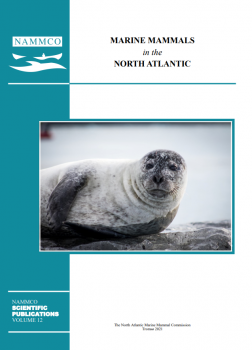29 September 2022: Recent trends in temporal and geographical variation in blubber thickness of common Minke whales (Balaenoptera acutorostrata acutorostrata) in the Northeast Atlantic
It is our pleasure to announce the publication of a new article published in Volume 12 of the NAMMCO Scientific Publications series – Marine Mammals in the North Atlantic.
The article Recent trends in temporal and geographical variation in blubber thickness of common Minke whales (Balaenoptera acutorostrata acutorostrata) in the Northeast Atlantic is authored by Hiroko Solvang, researcher at the Norwegian Institute of Marine Research (IMR) and co-authored by fellow Norwegian researchers Tore Haug (IMR and former member of the NAMMCO Scientific Committee) and Nils Øien (IMR and current member of the NAMMCO Scientific Committee).

ABSTRACT
The common minke whale (Balaenoptera acutorostrata acutorostrata) is a migratory species, and the summer period is generally characterized by intensive feeding and consequently seasonal fattening at high latitudes. The fat deposited is stored as energy reserves for overwintering at lower latitudes where feeding is supposed to be greatly reduced. It is therefore expected that their body condition on the summer feeding grounds will reflect foraging success during their most intensive feeding period and thus indicate how well the high latitude ecosystems can support the populations. During the commercial catch operations on feeding grounds in Norwegian waters, body condition data (blubber thickness and girth) have been collected from 13 937 common minke whales caught during the period 1993-2020. To investigate associations between body condition and area usage in minke whales, we applied three statistical approaches: regressions, canonical correlations, and spatiotemporal effect estimations. The analyses revealed a significant negative trend in blubber thickness from 1993 until 2015. After 2015, the trend was reversed, and blubber thickness values increased significantly. It has previously been suggested that there may be a link between the decreased minke whale blubber thickness and the abundance of the Northeast Arctic cod (Gadus morhua) stock which increased to a record high level between 2006 and 2013. Recruitment to the cod stock in more recent years has been low with a subsequent and continuous decrease in the total stock after 2013 to a current level which is presumably approximately 60% of the 2013 level. Interestingly, the observed common minke whale body condition was at its lowest in 2015, after which it has increased. This may support a connection between cod abundance and common minke whale body condition.
The full article is available here.
To learn more about the biology, conservation and management of whales in the North Atlantic and Arctic oceans, check our cetacean species pages here.


